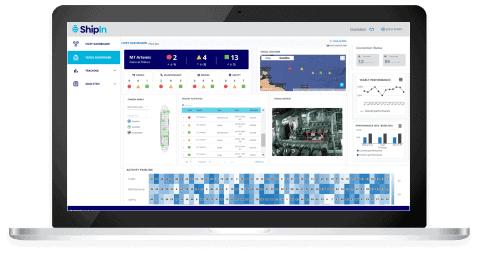When a ship leaves port, ship owners and fleet managers often have limited visibility into operations onboard.
It leaves many wondering:
- What maintenance activities are taking place?
- Are safety procedures followed?
- How efficiently will the ship load and unload at port?
- Is the cargo secure?
While the Captain’s reports and satellite communications can be helpful, there’s no replacement for knowing that your multi-million-dollar investment and assets are safe and sound while at sea.
Because of these concerns, maritime CCTV has become increasingly common onboard ships to provide a documented record of all crew and cargo activities. Using CCTV offers peace of mind that should a security or safety incident occur, you’ll be able to track down footage and understand exactly what happened and why.
In practice, however, marine CCTV has one major flaw: Someone has to watch all of that footage, either in real-time or after the fact.
You could hire a security team onboard to watch footage in real-time, or use someone ashore that would watch footage after the fact. However, not only does this require tens of thousands of hours when you multiply this over the course of your fleet, it’s expensive to maintain.
…and even if you do hire someone to watch that footage, it doesn’t always work the way it should. Luckily, there is a better way.
Why No One is Watching Your Maritime CCTV Footage
Have you ever tried to watch CCTV footage? Depending on the quality of the camera and the external conditions of the ship, it can be impossible to fully understand what is going on, or see the activities taking place, especially at night or during rough seas. It may be difficult to match up crew manifests to determine whether or not an individual on camera is actually a crew member and whether or not what they are doing is following protocols at that time.
Without additional context, most video footage is meaningless to the average employee. They don’t always know:
- Where is the ship, according to GPS?
- What time of day is the footage taking place?
- What is the status of the ship? Is it underway, or at port?
- How are the weather and sea conditions?
- What decisions have been made on the bridge prior to the footage?
- What tasks and operational duties are supposed to be taking place at this time?
In addition to lacking appropriate context, it’s unlikely any employee will be able to provide their undivided attention to the footage at all. That’s because most maritime CCTV networks require multiple cameras on the key areas of a ship, such as on the engineering deck, in the cargo hold, and on the bridge. It’s impossible to watch each screen at the same time without losing or missing information — and this is especially challenging when most safety incidents and hazards occur over the span of a few seconds.
The truth is, many hours of maritime CCTV footage remain unwatched and inaccessible to both onboard crew and management ashore, rendering the attempt to gain more visibility into your operations useless unless you want to evaluate footage after a major incident or event has occurred — but by then, it’s often too late.
ShipIn’s AI-Powered Maritime CCTV
ShipIn’s interconnected network of cameras doesn’t require you to hire someone to watch endless hours of footage from multiple cameras across multiple ships.
Instead, our proprietary artificial intelligence (AI) does the watching for you. In this way, our system can automatically surface the most important events in real-time, as they’re happening. If everything is going according to regulations, the dashboard is green. If something unusual occurs, you see a yellow anomaly alert or a red alert for a high risk event.

With the ShipIn FleetVision™ Platform, you can become proactive, instead of reactive. With real-time alerts into events onboard, you can act as needed in the moment — and make better decisions moving forward.
- We deliver a network of cameras to install onboard ship in vital operational areas, like the bridge, engineering room, and cargo
- The cameras record hundreds of hours of footage stored onboard
- AI analyzes this camera footage, syncing with other onboard systems to provide the necessary context needed, such as GPS location, AIS status, crew manifest, time of day, and more
- ShipIn alerts you in real-time if certain events occur or are missed, like routine maintenance or security risks
- This creates a digital logbook of events, such as maintenance carried out, safety hazards, or navigational changes so you don’t need to rely on manual logs
ShipIn’s AI learns as it processes this footage, so as time goes on, it becomes more attuned to the rhythms of your operational needs. What makes ShipIn more accessible than standard maritime CCTV is not just the layer of AI, but the ability to simultaneously access this data onboard ship and for management ashore.
Using a patented communication protocol that minimizes satellite bandwidth required, ShipIn’s FleetVision™ platform maximizes opportunities for efficient ship-to-shore communication. Ship owners, captains, and crew can all see the same information in real-time, working shoulder to shoulder to take appropriate steps to prevent further damage, initiate safety protocols, or receive updates as needed with nearly continuous communication and visibility into shipboard activities, behavior, and status.
Get More Visibility Into Your Operations with ShipIn
With ShipIn, owners, operators, and seafarers have advanced digital tools at their fingertips for safer and more productive voyages. Communicate more frequently with your teams, operate more efficiently, and mitigate security risks and incidents before they occur. Learn more how ShipIn can help your shipping organization today.


